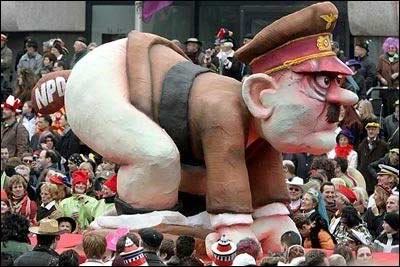My thanks to the reader who sent in a scan of a period Hoffmann postcard print of a photograph taken of Adolf Hitler signing the Munich Pact. The photograph shows the bronze desk set discussed in two earlier instalments.
As pointed out previously, the outer edges of the inkwells, inspired the Honour Temples built on Munich's Königsplatz in 1935 to house the remains of the sixteen National Socialists killed in front of the Feldherrnhalle in the 1923 Putsch, are not in line with the outer edges of the pen well. This non alignment is particularly clear in this photograph. The 1940 colour photograph reproduced below is even clearer.
 |
| Not quote the same as the real 1938-era desk set... |
In this photograph of the desk set claimed hailed by various parties, including more than a few print and television journalists who failed to carry out minimum due diligence, the outer edges or walls of the Honour Temple inkwells are perfectly aligned with the outer edges of the pen well.
Another reader wrote in to comment upon the letter from Lt John McConn to his parents, written on Adolf Hitler's personal stationery and dated 6.5.1945: "Look at the letter supposedly sent airmail by McConn. Wouldn't US troops have been using V-Mail for several months after the war and, also, regular US postal stamps would have been a low priority shipping item until well into the Allied occupation. Genuine V-Mail would be hard to fake while this document with civilian-type stamps and envelope would be much easier for a 'paper expert' to forge.".
Indeed. John McConn, 1st Lieutenant late of the 179th Infantry Regiment and a Silver Star holder, certainly existed and is, apparently, still alive. 1st Lt McConn apparently wrote the letter to his parents on 6.5.1945 on Adolf Hitler's personal stationery. He was serving with Company G, 179th Infantry Regiment, 45th Infantry Division at the time, as the envelope indicates, which raises questions of operational security. Would an officer have been able to send a letter with his unit details in clear? An 1989 article by Brigadier-General Felix L. Sparks, then the CO of the 3rd Battalion, 157th Infantry Regiment, also part of the 45th Infantry Division, contains the following passage: "On May 1, the following morning, I received an order to relieve the 15th Corps troops at the Dachau concentration camp. I thereupon sent Company L back to the camp. During the afternoon of May 3, both companies L and K were relieved of their concentration camp duties by the 179th Infantry Regiment of the 45th Infantry Division, never to return."
John McConn has said that he was stationed in the Führerbau, protecting the so-called Monuments Men and recovered artworks and treasures there, until the end of August 1945. Elements of the 45th Infantry Division were tasked with manning collection and dispersal points for surrendering German troops in and around Munich throughout the month of May 1945 before being repatriated to the USA in June. Neither he nor his family have responded to questions about their relationship with the American militaria dealers and television experts like Craig Gottlieb to whom the desk set was entrusted in 2008, 2010 and 2011. John McConn was described as having wished to auction the desk set himself, hence the promotional website set up on 19.3.2008 by Mr McConn's legal firm and Magnet Media Group, a movie production company with offices in Los Angeles, Cologne and London. MMG CEO Jeanette Buerling has not responded to questions about her company's involvement with the McConns and the Munich Pact Desk Set. Neither of the Californian militaria dealers, Steve Wolfe and his one-time runner Craig Gottlieb, have responded to questions about alleged Munich Pact desk set, said to have been 'sold' after an unsuccessful auction in New England to a "West Coast collector".




















